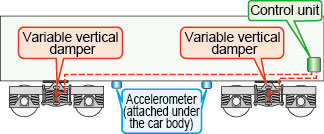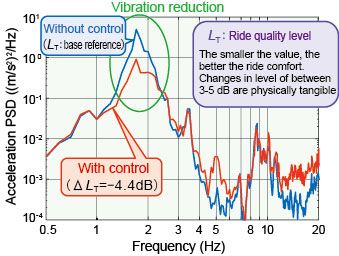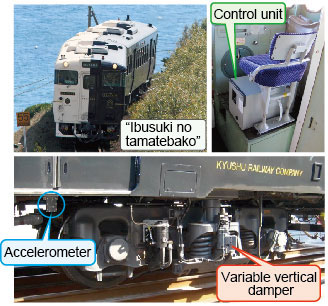1.Practical implementation of vibration suppression control system employing variable vertical dampers
- A vibration suppression control system has been practically implemented by means of attaching variable vertical dampers parallel to secondary suspension.
- Practical application of the system significantly reduces 1-2 Hz vertical car body vibration and tangibly improves ride comfort.
It has been observed that on track sections suffering relatively major track irregularity, 1-2 Hz vertical vibration causes considerable ride discomfort. A system for attenuating vertical car body vibration has therefore been put into practice which relies on variable vertical dampers whose damping force can be controlled and are installed parallel to the secondary suspension (Fig.1).
A variable vertical damper was designed with a single valve capable of offering both the failsafe and damping force control functions, with a view to meeting the demands of reliability and low cost required for the system to be applicable in practice.
Additional functions were added to the control unit for controlling the damping force and monitoring the overall system for any abnormalities. One of the failure detection function’s special features is the algorithm which was developed to identify abnormalities in the damping force based on the signal picked up from the accelerometers for controlling. The system has therefore been designed to detect any problems, and not to measure the attenuation force itself. If any problems are detected, power is automatically cut off to the damper, and the train can run relying on its ordinary damping gear.
Results from running tests with the present system demonstrated a significant reduction in vertical car body vibration and a fall in the ride quality level (LT) , which is a representative index for evaluating the ride comfort of railway vehicles in Japan, of approximately 4 dB (Fig.2).
This system is now in operation on the JR Kyushu “Ibusuki no Tamatebako” sightseeing express train. It is the first practical application in the world of a railway vertical vibration suppression control system (Fig.3).

Fig.1 Illustration of the vertical vibration suppression control system
Fig.2 Example of resulting reduction achieved with the control
system (PSD of vertical carbody acceleration directly above
the bogie at a speed of 73 km/h)
Fig.3 Pictures of the variable vertical damper and accelerometer built onto the “Ibusuki no tamatebako” sightseeing express train